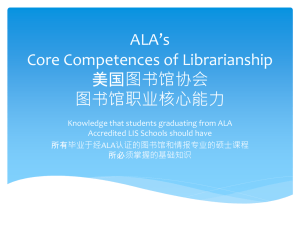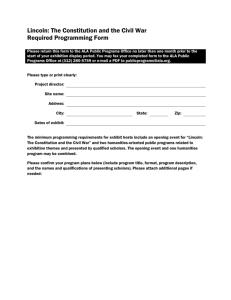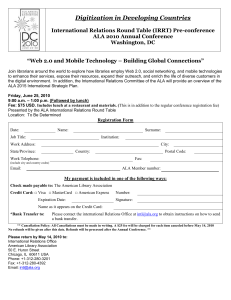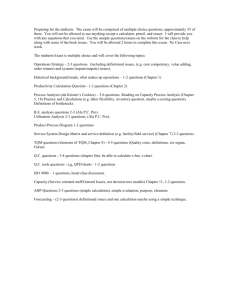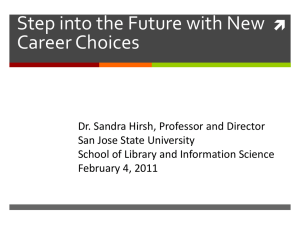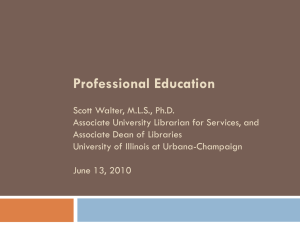File1
advertisement
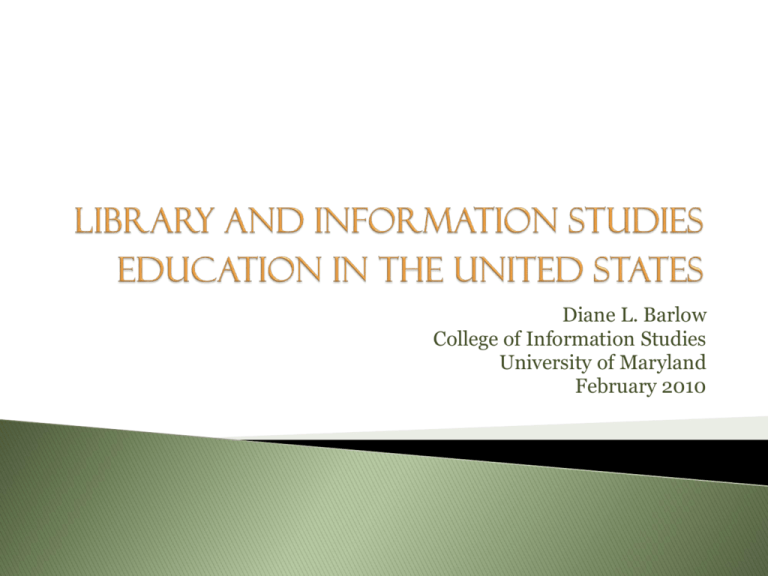
Diane L. Barlow College of Information Studies University of Maryland February 2010 Introduction to library and information studies (LIS) education in the US Growth in LIS education Changes in instruction and curricula iSchool movement ALA competencies Basics Computer Science Information Systems Electrical Engineering Communications Journalism Management Informatics Psychology Public Policy Decision Sciences Education Library and Information Services Health Sciences Others Graduate programs 2 years to complete 1/3 required courses -- 2/3 elective courses Specialize by type of library, type of work or other areas Fulltime faculty and part-time faculty Accredited by the American Library Association (ALA) Committee on Accreditation 2008 Standards for the Accreditation of Master’s Programs of Library and Information Studies ◦ ◦ ◦ ◦ ◦ ◦ Mission, goals, and objectives Curriculum Faculty Students Administration and financial support Physical resources and facilities www.ala.org click on “Education & Careers” Increased participation Increased access Growth in the number of educational programs ◦ 1980 – 1995 18 programs closed ◦ 1995 – 2010 1 program closed 5 programs opened ◦ 2010: 62 programs accredited by ALA and 4 programs progressing toward accreditation Growth in the number of students ◦ 1992: 5,122 students in LIS programs ◦ 2008: 19,340 students in LIS programs Source: ALA Office on Accreditation Increase in distance education Good job outlook 1996 ◦ 38 programs ◦ 899 courses 2004-2010 ◦ 46 programs ◦ 1044 courses Sources: ALA Office on Accreditation, ALISE Statistical Reports “… job opportunities are expected to be favorable, as a large number of librarians are likely to retire in the coming decade.” Source: Occupational Outlook Handbook, U.S. Department of Labor New perspectives New audiences New opportunities Foundations of the field Reference Organization of information Management Research methods or information technology Source: (Markey, 2004) Web 2.0 technologies ◦ ◦ ◦ ◦ Use in coursework is scattered Experiments – lots of experiments Learning about rather than learning with Research into the effectiveness for learning is needed Virtual reality ◦ http://slisweb.sjsu.edu/sl/index.php/Main_Page “…six uses for this virtual worlds platform that show direct benefits for LIS students: Groups and Events - begin support groups and hold community events Interfaces and Web Connectivity - connect database and applications to the 3D setting Professional Services Role-play - practice interacting with clients and interviewing them Commerce and Creativity - build and sell interesting objects Personal Discovery and Identity - create a new persona and practice in business settings Marketing and Outreach - create a new branch and promote your current services” Source: http://slisweb.sjsu.edu/sl/index.php/Main_Page Definitions of users ◦ More differentiated definitions ◦ More inclusive definitions Expansion into new areas ◦ New topics ◦ New degrees LIS schools with other degree programs, 2005: Undergraduate major or minor in library science Undergraduate major or minor in information science Master’s degree in information science Master’s degree in another discipline Post-master’s certificate Doctoral program 5 16 5 17 32 30 More than a change of name LIS programs that have expanded into other information domains Computer science programs Information systems programs 27 Members ◦ ◦ ◦ ◦ ◦ ◦ ◦ Canada China Denmark England Germany Singapore United States Annual conference 1965 1967 2003 2010 Master of Library Science Doctor of Philosophy Master of Information Management Undergraduate I-courses Post-master’s certificate programs 2011 Master of Human-Computer Interaction Centers and Labs ◦ ◦ ◦ ◦ ◦ ◦ Information Policy & E-Government Library & Information Innovation Advanced Study of Communities & Information Cloud Computing Human-Computer Interaction Lab Maryland Institute for Technology in the Humanities Hot topic Foundations of the Profession Information Resources Organization of Recorded Knowledge and Information Technological Knowledge and Skills Reference and User Services Research Continuing Education and Lifelong Learning Administration and Management ◦ http://www.ala.org/ala/educationcareers/careers/corecomp/corecompetences/index.cfm Younger students are entering programs Diversity is not increasing Federal and foundation funding is available for research and program development Interest in international learning opportunities is growing Good health ◦ ◦ ◦ ◦ Growing Experimenting Changing Expanding Stresses ◦ Competition ◦ Scarce resources ◦ Internal tensions
